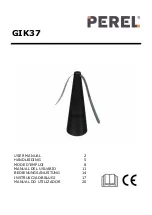
GLOSSARY
Many technical terms, which are familiar to lighting programmers, could be unknown for new
users, while other terms used in this manual are referred specifically to the use of this console. We
suggest you to read the glossary that follows, in order to introduce you to the technical terms and
to the fundamental concepts used in the manual. Even if they would be not immediately clear,
certainly they will help you to understand the instructions coming after.
Attribute/Parameter
Single function of a fixture which is controllable via DMX such as: dimmers, pan, tilt, color wheel,
gobo wheel, etc.
Button
Element of the LCD display graphical interface to press in order to activate the corresponding
function. It differs from the switch which is an actual key of the console.
Controller
Controller Slider and Switch freely configurable as: “Grand master”, “Group Master” or Register
slider. The Register slider can be configured as “Master intensity”, Master size”, “Master speed” or
“Cross fade”.
Cue
Defines the status of an array of attributes/parameters saved in the SD internal memory: it is often
known as ‘Scene’ or ‘Memory’.
Qlist (list of Cues)
An ordered set of cues, in this manual it is also quoted as cue list.
Cue‐list timing
A set of values which define the timing behavior between individual cues of the Qlist.
DBO (dead blackout)
Operation that voids (turns at zero) all HTP channels of the console.
Editor
Environment that allows to create and edit cues and palettes. The editor has priority over all
playback functions.
Empty
Attribute without an assigned status/value. When you save a cue, only the assigned attributes are
saved and the empty attributes are discarded.
Fixture
A generic term for any projector or device controlled through DMX.
Flash
A key that takes to 100% the HTP channel/Dimmer of one or more fixtures.
8
Содержание QUIVER
Страница 1: ...User Manual English Software Release 1 10...
Страница 61: ...61...








































